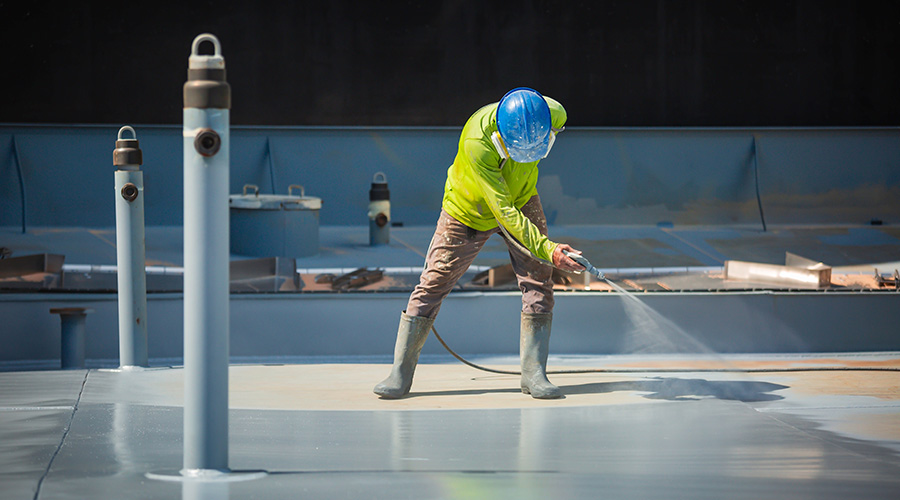Painting Projects: Strategies for Success
High-quality equipment and paints, along with concern for occupants, can produce projects that last and look good
Managers rely on paints and coatings to protect walls and other interior surfaces of institutional and commercial facilities, while at the same time enhancing the appearance of these surfaces. But paints are only one element in a successful paint-application program.
To maximize efficiency, painting crews also require a range of tools and equipment, including brushes, ladders and paint sprayers. By cost-effectively specifying these types of products, managers will be more successful in scheduling and carrying out painting projects that protect interior surfaces while minimizing disruptions to facility operations.
The Planning Stages
Most costs related to paint applications are heavily weighted toward labor. Managers can verify a project’s relative costs by comparing these factors in their experiences with painting projects, or by checking the current manuals of painting-cost estimates, which break down labor and material unit costs separately.
For instance, the manuals show that costs for interior floor, wall and ceiling paint and coating applications typically are comprised of 70-80 percent labor and 20-30 percent material. Managers also can note the exceptions, such as floor coatings, by checking specific kinds of paint applications to determine their relative labor-material weights.
Proper preparation also is essential for ensuring attractive, long-lasting, low-cost jobs. This step includes ensuring that paint crews have the right tools, file and sand rough spots, clean surfaces thoroughly to remove grease and loose material, and dry the surface well.
Workers should apply a sealer coating to the substrate before painting in some cases, such as when painting over new plaster, wall board or heavily soiled surfaces.
Application Considerations
Using a typical labor-heavy ratio, managers should pay careful attention to application methods because of the effect the application method has on labor hours. For example, it is faster to use roller-handle extensions, foot-wearable stilts, or aerial personnel lifts instead of setting up and removing scaffold sections.
Using a pressure-feed device to keep the roller filled is faster than manually dipping the roller in a paint tray each time. These methods make a tremendous difference in the application rate and labor hours. Using a spray application, rather than a roller or brush, for open web steel ceiling joists or other irregular surfaces also can increase application rates substantially.
On trim applications, using masking tape and a trim brush or roller guide is faster than brushing or rolling the paint on free-hand. Workers can use natural or synthetic bristles with oil-based paints, but they should use only synthetic bristles for latex paints because natural bristles tend to absorb water and clog.
Equipment spotlight
Selecting the right brush size might mean buying brushes, but it is worth the price when the result is shorter application times. Crews should use 3- or 4-inch square brushes for wide moldings and 1- or 11⁄2-inch angle brushes for window sashes and narrow moldings. For larger flat surfaces and wall areas, workers should use a 4- to 51⁄2-inch brush, a roller, or a pad.
In specifying rollers, managers have four considerations to keep in mind: the handle, frame, roller core, and roller nap.
The handle should be threaded for an extension that can provide access to ceilings and hard-to-reach wall areas from the floor.
The frame is the part of the roller on which the core fits. A heavy wire frame adjustable for the core’s width adds size flexibility for different jobs from a few inches to 18-inch widths.
Cores are made of cardboard or plastic. Cardboard more easily softens, and glue holding the nap can dissolve due to solvent in the paint. Better rollers have cores that are plastic-coated cardboard or, even better, plastic thermally bonded to the nap.
Different paints require different nap materials. Natural lambskin fibers are best for alkyds but synthetic fibers work well with latex. Mohair or woven fabric works well for high-sheen coatings, varnishes and shellacs. Special solvent-resistant covers and fibers are best for epoxies and urethanes because of their strong solvent content.
For rougher surfaces, workers should use a thicker roller nap. For example, painting concrete block or heavy stucco requires a 3⁄4- to 11⁄4-inch nap. Most smooth interior walls and ceilings require a 3/8-inch nap, and for enamel on a smooth surface, use a 1⁄4–inch nap.
Pad applicators also can help crews move quickly. Because they are flat, they: reduce splatter; fit into corners and along ceiling lines and trim or where different colors meet; feature guide wheels for straight lines; and adapt to a pressure-fed, trigger-controlled attachment for supplying paint.
Scheduling for Success
Managers and occupants do not like interruptions to facility operations. When painting is in progress, the space essentially is unusable due to moved furniture, the presence of floor and furniture covers, and, often, reduced air quality. Paint and coating selection can have a major impact on scheduling. Managers should always choose material quality over unit cost because if top-quality materials can double the life of the paint job, the result is one-half the possible interruptions and much happier occupants and managers. It also cuts labor and material costs in half.
Also, a second coat is more cost-effective than two first coats spread over time because preparation for the second coat is minimal. This approach also is a good way to use the remaining paint and reduce the amount of recycling or other disposal. Later, all workers need to do to keep the surface looking fresh, bright and clean in between repainting is wash it and touch up a few high-traffic areas.
Attachments for power-fed rollers and pads are important tools that can shorten a paint job and minimize disruptions to users’ schedules. These tools attach directly to the paint can, eliminating the paint-transfer steps. They have spatter shields, fingertip flow control, extension handles, and tubing that connects from the power-feed unit to the roller.
These tools also offer quick-cleaning features that shorten cleanup time. Many users claim all these impressive features result in getting paint jobs done in less than one-half the time it would take using conventional methods.
Deciding when to paint depends on occupancy schedules. For example, workers in most commercial facilities and schools can perform large painting projects at night, during the summer, or over holidays, when few, if any, occupants are present.
Hospitals are occupied 24-7-365, so managers are more likely to schedule painting projects on a room-by-room basis. Some managers also take advantage of holidays and vacation peaks, when elective procedures involving overnight stays are less frequent. In between, managers can schedule touch-ups using quick-drying, odor-free paint with little inconvenience to patients or staff.
One Last Look
A final walk-through is an important part of any paint-application project, so managers should include time for this activity in the schedule. If a contractor is involved in the project, the contractor and the owner’s representative should perform the walk-through, using a copy of the project specifications and checking each area against the specifications to ensure quality and completeness.
Some specifications include a testing section requiring completed work samples to be taken in the presence of the contractor and sent to an independent lab for examination to ensure the specifications have been met as to thickness of coats, quality of the paint, coverage, surface uniformity, and paint-material composition. If a particular surface doesn’t measure up, the contractor does that part of the job over.
A combination of top-of-the-line materials, high-quality tools, methods that reduce labor content while maintaining high quality, and proper attention to scheduling with the customer in mind, can produce high marks for the painting program.
Related Topics:











